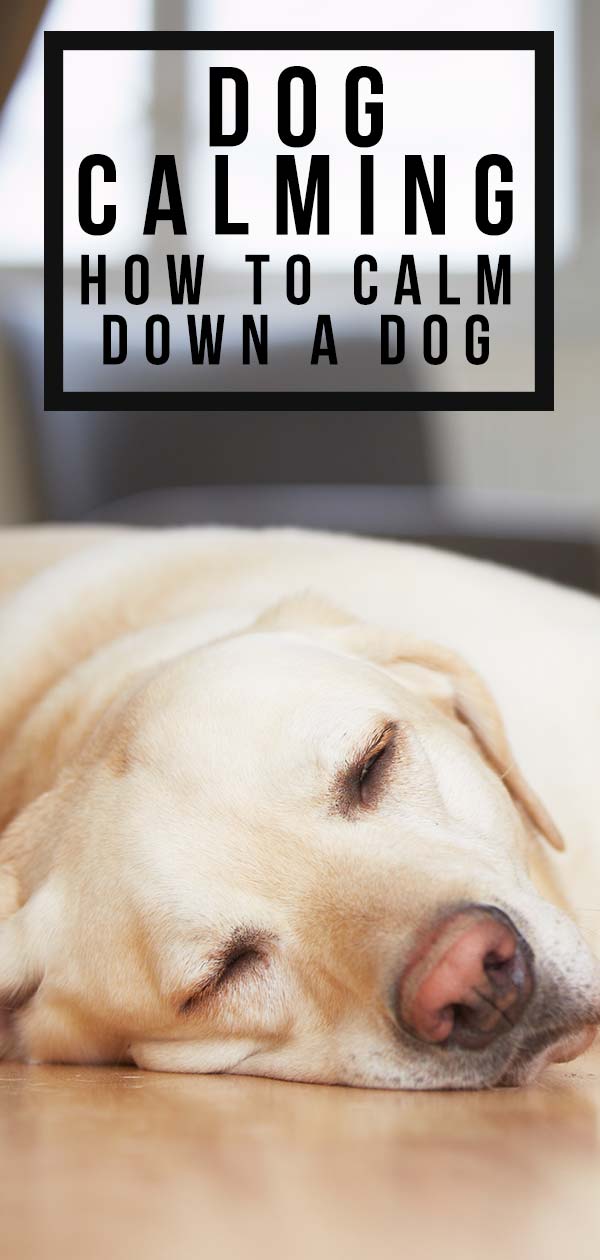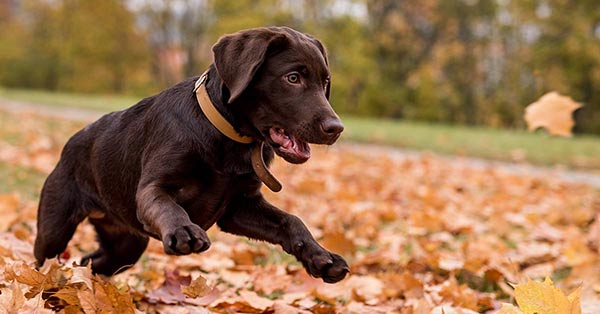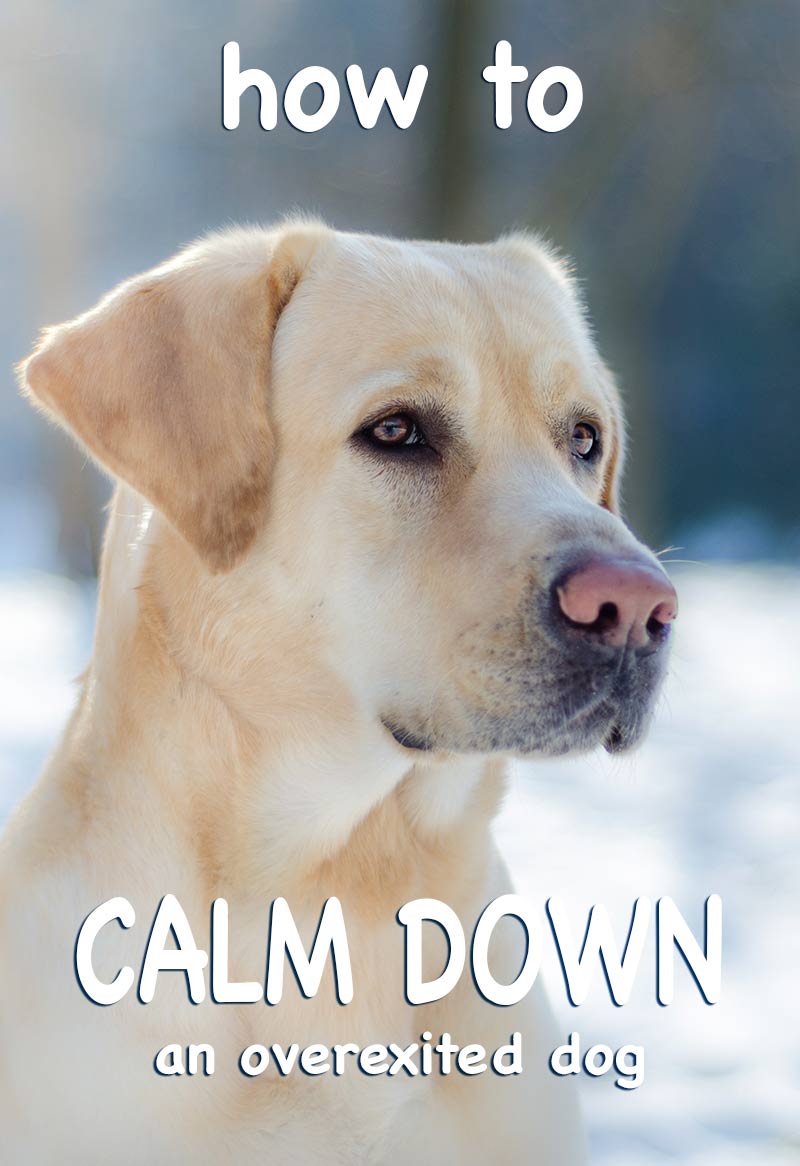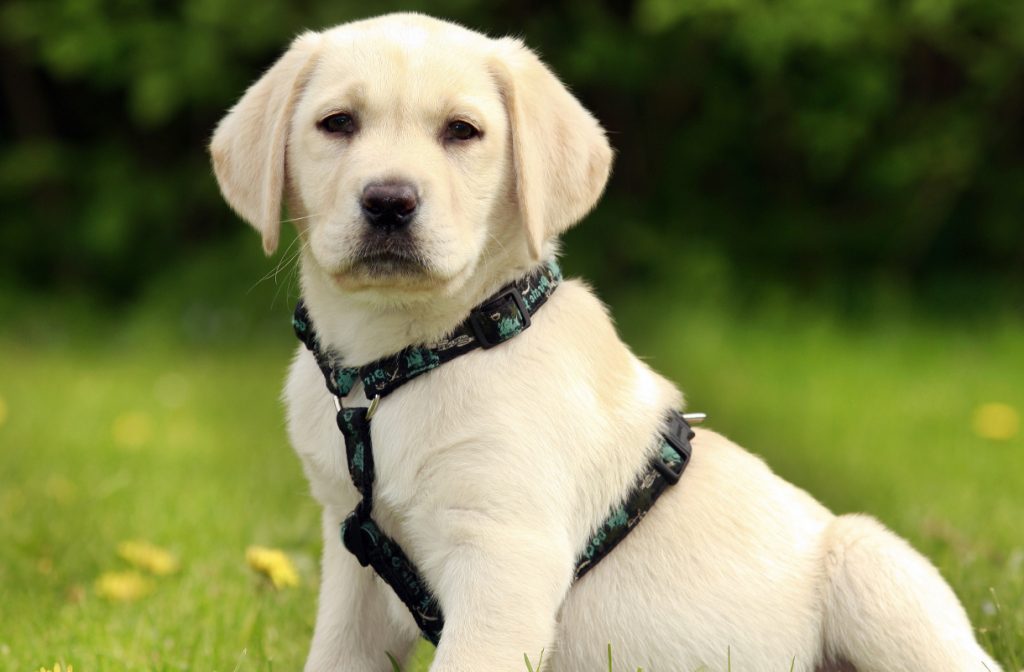How To Make A Puppy Calm Down

All dogs can get over-excited, or upset at times, whether they are puppies or adults. So knowing how to calm a dog can be a big help to any dog parent.
We'll give you some great tips for calming an excited dog, and look at ways to calm a dog that is agitated or upset.
You can also get more general training tips sent to your inbox by dropping your email in the box below.
Products included in this article were carefully and independently selected by the Labrador Site team. If you decide to make a purchase from one of the links marked by an asterisk, we may earn a small commission on that sale. This is at no extra cost to you.
How to Calm Down a Dog
A great many people search the internet for help with how to make a dog calm down.

But the answer isn't as simple as a 'one size fits all' solution.
Because the best way to calm down an anxious dog isn't the same as the best way to calm down a hyper dog.
And you'll need different coping mechanisms in place to calm down a puppy, compared to an adult dog.
Since these situations are different, you can use the menu box below to skip to the one you're most concerned about.
Or read through the whole article with us to see how different dog calming techniques compare, and when to use them!
Let's get started!
How to Calm Down a Hyper Dog
If you own a young Lab between 7 and 8 months of age, it won't surprise you that more people are searching online for "when do Labs calm down?" than any other breed of dog.
It's not just because Labs are especially bouncy of course, but also because they are popular and big.
A large bouncy dog usually makes more impact on those around him than a small one.
"When do Labs calm down?" someone asked me recently, "He is just such a handful!"
And it's true, a boisterous young Labrador can be quite a handful.
But fortunately there are several things that we can do to help our young Labs relax and calm down a little.
8 Months Old and the Boisterous Stage
It is not unusual for young Labs between 8 and 12 months of age to start causing injuries through their exuberance.
Knocking children over, barging into old ladies, and jumping up at visitors are common crimes.
This is the peak age for excitable behavior.
It can feel as though every social occasion is doomed to end up in tears.
And it is no coincidence that this is the age at which many rescue dogs are given up to animal shelters or simply abandoned.
When do Puppies Calm Down?
Puppies generally reach a peak of bounciness and mischief at 5-8 months old.
Smaller breeds often mature more quickly and may be pretty sensible by the time they are 9 months old or so.
Big dogs often mature more slowly, mentally as well as physically.
When do Labs Calm Down?
Labs can be a little later than the average puppy in reaching the point at which you suddenly realise your pup is all grown up. But hang in there, it will come!

With the right handling techniques, most young Labradors begin to calm down around their first birthday. And are fairly 'settled' in temperament by the time they are eighteen months old.
In a moment we'll look at ways to avoid some of the excitable puppy behavior that causes problems.
But first let's look at how to cope when your Lab is on his worst hyper behavior
What do I Mean by Hyper Dog?
A hyper dog is not a happy dog. He might seem happy as he leaps about – air nipping, barking, jumping at people, and so on.
But he is actually a dog that doesn't know where to put himself. And he is often actually quite upset.
Many people are quite shocked when the nice game they were playing with their young dog begins to get rougher and rougher.
You may be tempted to shout at your dog if he nips you, or to give out a squeal.
Angry Behavior Won't Help
Unfortunately, noises and angry behavior from you excites the dog more, until eventually he loses control completely
If you are scared, your dog will be scared too, and like most scared kids will behave even more inappropriately. So it's really important that you intervene before things get to this point.
Remember that the hyper dog isn't able to listen. He's completely over the threshold and unable to calm himself.
He needs you to help him.
How to Calm Down a Dog – 5 Steps
There are five steps you need to complete in order to calm down a hyper dog.

The first two steps help you cope with the situation when it arises.
The remaining three steps help to prevent your dog having a hyper episode in the future.
- Take control of your dog
- Calm your dog
- Change what you do around your dog
- Provide activities for your dog
- Teach your dog to relax
Let's take each of these in turn
Step 1: Take Control of Your Dog
This is about physically managing your dog to make sure he doesn't hurt you or anyone else.
It is important to be able to control a lively young Lab and you'll find this easier to do if he is wearing a body harness.

You do not want to fight to clip a leash on a 70lb dog while he is nipping your sleeves or barking in your face.
So have him wear a training leash outdoors and a house line indoors.
Don't take them off until you put him in his crate or sleeping area and leave him on his own.
Never use a choke chain or slip lead on a dog that has hyper episodes. He doesn't know his own strength and he'll hurt his neck.
Step 2: Calming Your Dog
Outdoors, the best thing to do is stop whatever you were doing with the dog when he got carried away, and start briskly leash walking.
Don't hesitate, or try to engage a leaping, nipping dog in conversation – just pick up the leash and start walking.
Keep walking until the dog begins to relax as he walks along next to you.
If other people, children, or animals were exciting your dog, move him away from them.
Walking briskly but calmly around can help to lower your dog's arousal level and let you get back in control of the situation.
Indoors you can use time out. Stop all play and place the dog in a crate or room by himself to calm down for a few minutes.
Give yourself a chance to calm down too, before bringing the dog back out again.
Step 3: Change What You do Around Your Dog
Very often dog owners unwittingly cause excitability, or at least contribute towards it, by their own behavior.
It is not difficult to 'wind up' a young dog.
This is not your fault. It's just that humans and dogs play differently and interpret one another's behavior differently.
It's a kind of language barrier if you like.
Fortunately, you can soon put all this right.
Top Tip – be Low Key
Lots of over excited greeting and squeaky voices are rewarding for your excited puppy.
Pretend to be underwhelmed by your dog.
Talk to him quietly and calmly, and persuade other family members to do the same.
Top Tip – Avoid Physical Play
Another common mistake that new puppy parents make, is getting involved in a lot of physical play with a large young dog.
Inexperienced owners and teenage children often rough-house with a dog, pushing and pulling him, even rolling on the ground with him.
This is something you will need to avoid completely in future.
Have a look at this article – how to play safely with your dog – for better ways to engage with your growing puppy.
Top Tip – Don't Ignore the Calm!
Your dog will be calm sometimes. Don't ignore those times.
A while back my husband took one of our dogs to the vet for a booster.
An elderly couple arrived with their Golden Retriever. The young dog lay down quietly and the owners ignored it completely, chatting to one another.
After a few minutes the dog whined, and both owners turned to make a fuss of him. They then started chatting again, ignoring the now quiet dog.
Each time the dog whined, the owners paid him attention, and each time he lay quietly they ignored him.
This Encouraged Agitated Beahvior
Within twenty minutes, the dog was whining constantly and starting to become agitated.
They were no doubt convinced that the dog was upset because he was at the vets, when in fact he had been perfectly happy when he arrived.
The moral of this story is: rewarding and reinforcing good, calm, behavior is very important.
Step 4: Provide Activities for Your Dog
Young Labradors need exercise, mental stimulation and attention, but it needs to be the right sort of exercise and the right sort of attention.
Ignoring bad behavior, jumping, nipping and so on is important. But it is not the end of the story.
Your young dog needs an appropriate way of engaging with his family.
The Best Ways to Engage
The way to achieve this is through exercise, training and brain games.
Indoors, you can use puzzle toys and indoor games to entertain your dog in a calm and controlled way.
Outdoors you can focus on training your dog to do what he was born to do – fetch stuff for you.
Once his body and brain are tired, and you have put a stop to all rough play, you'll find your dog's behavior improving.
But there is one more thing you can do to help.
Step 5: Teach Your Dog to Relax
This is the final step in the process and the icing on the cake.
Dogs can be taught and encouraged to relax at home, and even in public places. You'll find this a useful skill to teach your dog.
It's a whole topic of its own. So do check out our 'Teach your dog to relax article'.
How to Calm an Anxious Dog
The laid back Labrador isn't a breed people typically associate with nervousness.
But nonetheless some Labs do experience anxiety, and some individuals are more disposed to be nervous of things than others.
Bad experiences in the past can make Lab anxious of repeating the encounter. Labs can also experience separation anxiety, or anxiety relating to old age.
The behavior of an anxious dog is very different to that of an over excited dog, so the process for how to calm an anxious dog is different to managing an excited dog.
Recognizing an Anxious Dog
Signs your Labrador is anxious include:
- panting
- drooling
- pacing
- barking
- restlessness
- toileting inside the house
- destructive, repetitive or compulsive behavior.
The key to helping an anxious Labrador is to learn to read his signals when he tells you he is nervous.
Don't attempt to push through them because his worries seem irrational to us, or you think he "should" be able to do something.
Always keep him at a point where he feels safe, then use training, counter conditioning, and medication if your vet recommends it to build up his tolerance and confidence around the thing which made him nervous.
You can read more about nervous Labradors here, and in the following section.
How to Calm Down a Scared Dog
Sometimes a Lab's nerves are more than just jitters – he is outright fearful.
Moments of acute fear can happy to the most confident and happy-go-lucky of dogs, often in response to a powerful trigger, such as fireworks.
Signs your dog is frightened include:
- yawning
- nose licking
- dilated pupils
- trying to move away
- barking
- and growling.
Calming Frightened Dogs
Frightened dogs need to be separated from the thing that is frightening them.
You cannot hope to calm down a scared dog while the thing scaring them is still there.
Your Lab will only continue to get more scared, and eventually resort to aggression to try and drive the thing scaring them away.
How to Calm Down a Dog: Tackling Specific Situations
So far we've looked at how to manage dogs whose general disposition requires some calming influence.
But lots of Labrador owners visit this site and our forum looking for how to calm a dog down during a very specific event.
The next few headings are a round up of the most common questions we hear, and links to the pages where we have covered their answers in detail.
Then, we'll look at calming aids you can purchase for your Lab, including medications and music.
How to Calm Down a Dog During Fireworks
Fireworks are perhaps the most famous dog frightener of all.
Most dogs will only experience them once or twice a year, which limits the opportunity for socialising them to the sounds at an early age.
We've written about helping Labs during fireworks here.
How to Calm a Dog Down in the Car
Some Labs are happy to spend a road trip asleep in the trunk. Others don't seem to be able to settle.
Sometimes it's because they've learned to associate car trips with a really exciting destination – the beach for example – and they're excited.
These dogs might benefit from something calming and productive to occupy their time, like a favorite plush toy or blanket.
Or, since Labs are remarkably quick at learning landmarks, covering their travel crate in a blanket might keep them guessing your route until you've reached the end.
Other times, Labs can be unsettled in the car because car sickness is making them feel uncomfortable and anxious.
We've written more about how to cope with that scenario here.
How to Calm Down a Barking Dog
Dogs bark for a lot of different reasons, but whatever the trigger, our first thought is usually "how can I make it stop?"
We have a whole Barking Center dedicated to this and full of resources for working out why your dog is barking, and how to calm him back down to silence.
How to Calm Down a Female Dog in Heat
For owners of unspayed female Labradors, going into heat is going to be a feature of your lives from around the age of 10 months onwards.
Besides the physical signs, you might notice your female Labrador's behavior is also out of sorts during heat.
Some girls become apprehensive and irritable while on heat, and you might notice they're more reactive.
We've got lots of information about caring for your female Lab during heat here.
How to Calm a Dog Down for Nail Clipping
Clipping your Lab's nails is a necessary chore.
Getting them used to it from an early age helps.
But if your Labrador already runs a mile at the sight of the clippers, it's never too late to help them calm down for nail clipping.
This article is all about teaching your Lab to feel positively about nail clipping.
And this article ties up that process with some practical tips for getting the job done quickly.
How to Calm Down a Dog in a Crate
Lots of new Labrador owners hope to rely on crating their dog for short periods.
But settling calmly in a crate is a learned skill for many dogs.
There isn't a quick fix to calm down a dog who gets agitated in their crate.
But our crate training guide will show you the steps to get there with time and patience.
What Can I Give my Dog to Calm Down?
For the final part of this article, we're going to look at some popular dog calming aids owners turn to, and ask which really work, and which won't make a difference?
Calming Pills for Dogs: How to Calm a Dog Down with Medication
Whether it's possible to calm a dog down with medication depends upon why your Lab isn't calm to start off with.
It's a good idea to have a chat with your vet if you are worried about your dog's behavior.
Especially if changes in behavior have been sudden, or if your dog seems to be showing signs of aggression.
If your pup is simply energetic and boisterous, then your vet is not likely to prescribe any kind of drug to alter their activity levels.
But if they are stressed or anxious, there are remedies your vet might suggest to help ease their mood, for example dexmedetomidine (sold as Precedex).
Benadryl
A lot of dog owners also ask "can I give my dog Benadryl to calm them down?"
We've written about using Benadryl for dogs here. But whilst it's tempting to reach for an over the counter solution, we don't recommend it without veterinary guidance.
Not least because the active ingredient has also been linked to increased excitement and nervousness in dogs!

Adaptil for Calm Dogs
One of the most popular pharmaceutical products for dog calming is Adaptil for dogs.
Adaptil comes in plug-in diffusers and specially infused calming collars* for dogs.

Both contain dog appeasement pheromone (DAP).
There is evidence that DAP can relieve the signs of stress and anxiety during car journeys, fireworks, thunderstorms, and overwhelming social situations.
However, what it cannot do is magically make a happy and bouncy dog less bouncy.
Which is why it's so important to understand why your dog isn't calm in the first place.
Calming Music for Dogs
A different approach altogether, and one many dog owners are interested in, is using calming music for dogs.
We've previously examined the way music makes dogs feel in this article.
Calming sounds for dogs, such as this popular compilation*, can be used alongside other strategies to help your Lab cope with thunderstorms, separation anxiety and changes such as moving house.

 How to Calm Down a Dog
How to Calm Down a Dog
I hope this article has equipped you with lots of ideas for calming down your Labrador.
If you feel like you're living at the mercy of a hyper puppy, take comfort in the fact that dogs learn fast.
Most young dogs grow out of this phase very quickly if people around them are consistent and reward the right behaviors.
If you're trying to ease the distress of an anxious or scared Labrador, have heart that there are many avenues to explore, and ways to help your dog.
You might also find it helpful to join our forum. There you can chat to the many other dog owners who have been through what you are experiencing, and come out the other side in one piece!
This article has been extensively reviewed and improved for 2019.
Affiliate link disclosure: Links in this article marked with an * are affiliate links, and we may receive a small commission if you purchase these products. However, we selected them for inclusion independently, and all of the views expressed in this article are our own.
References and Resources
- Bray et al, Increasing arousal enhances inhibitory control in calm but not excitable dogs, Animal Cognition, 2015.
- Sheppard et al, Evaluation of dog-appeasing pheromone as a potential treatment for dogs fearful of fireworks, Vet Record 2003.
- Gates et al, Owner perceptions and management of the adverse behavioral effects of fireworks on companion animals: an update, New Zealand Veterinary Journal, 2019.
- Landsberg et al, Dog-appeasing pheromone collars reduce sound-induced fear and anxiety in beagle dogs: a placebo-controlled study, The Veterinary Record, 2015.
- Siracrusa, Treatments affecting dog behavior: something to be aware of, Vet Record, 2016.
- Estelles & Mills, Signs of travel-related problems in dogs and their response to treatment with dog-appeasing pheromone, Veterinary Record, 2006.
- Dananberg & Landsberg, Effects of dog-appeasing pheromones on anxiety and fear in puppies during training and on long-term socialization, JAVMA, 2008.
- Korpivaara et al, Dexmedetomidine oromucosal gel for noise-associated acute anxiety and fear in dogs-a randomised, double-blind, placebo-controlled clinical study, Veterinary Record, 2017.

The Labrador Site Founder

Pippa Mattinson is the best selling author of The Happy Puppy Handbook, the Labrador Handbook, Choosing The Perfect Puppy, and Total Recall.
She is also the founder of the Gundog Trust and the Dogsnet Online Training Program
Pippa's online training courses were launched in 2019 and you can find the latest course dates on the Dogsnet website
How To Make A Puppy Calm Down
Source: https://www.thelabradorsite.com/how-to-calm-down-a-dog/
Posted by: schultetram1959.blogspot.com

0 Response to "How To Make A Puppy Calm Down"
Post a Comment